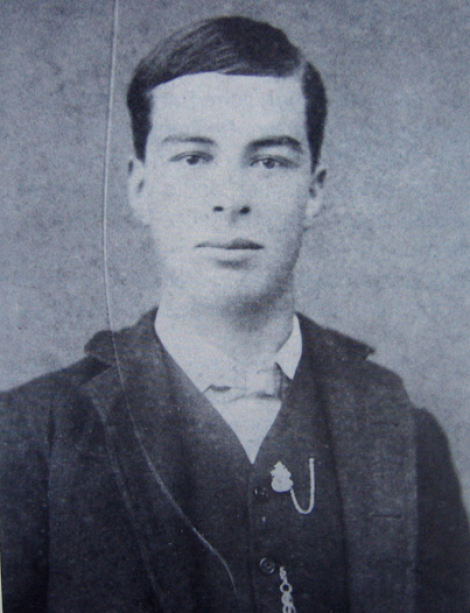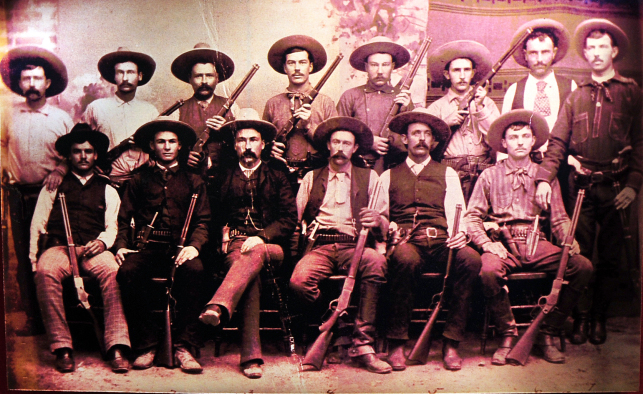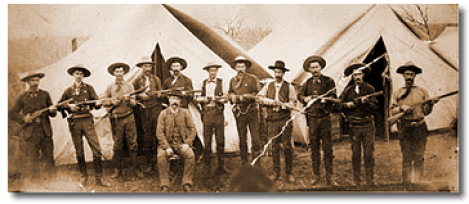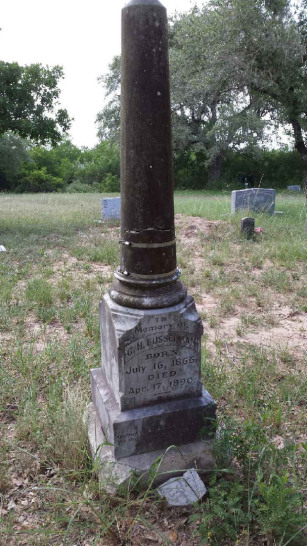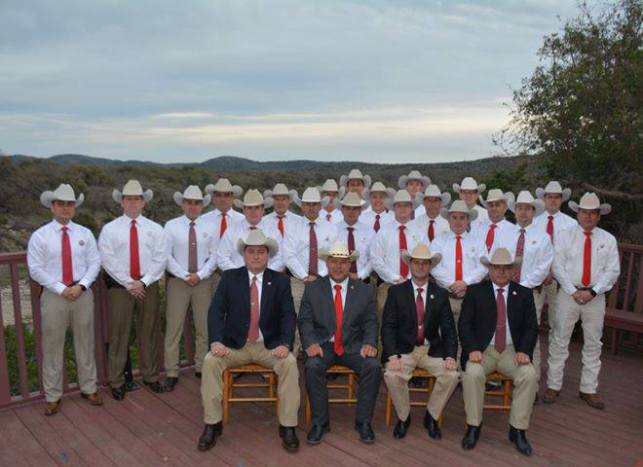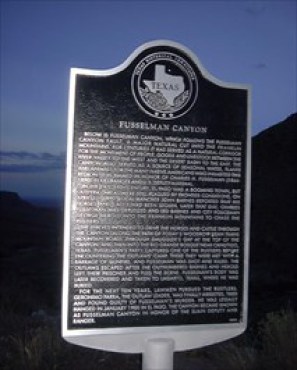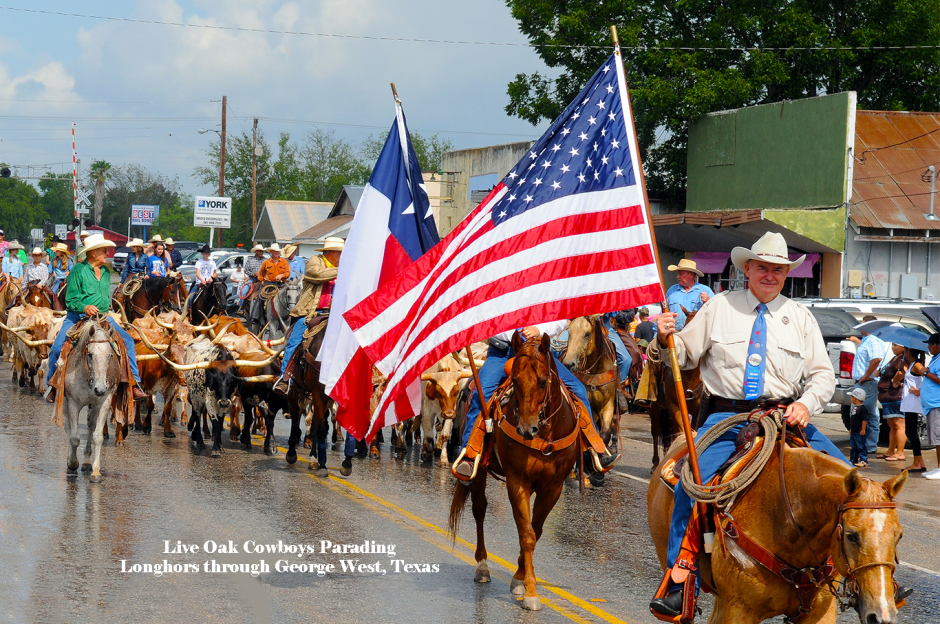
F Surnames - Live Oak County Oral History Collection
Charles Henry Vanvalkenburg Fusselman "Fusselman Immortalized" - 1866 - 1900 (1) Orange Grove Area Museum, Orange Grove, Texas Archive Room- "Lagarto Scrapbook", Unnamed Author below; (2)Link to Texas Ranger Hall of Fame magazine for full story; (3)Fusselman Canyon Marker, Franklin Mountains, El Paso County. Waymark Gallery.
Charles Fusselman, center back row, Texas Rangers, Company D, stationed at Marfa, Presidio County, Texas circa 1887. The canyon where Fusselman gave his life when killed by cattle rustlers in the Franklin Mountains was named for him. Photo courtesy Buckhorn Saloon and Museum, San Antonio, Texas. Archival rendition by Richard Hudson.
Charley Fusselman
Charley Henry Vanvalkenburg Fusselman was born July 16, 1866, to John and Abigail Anna (Thrasher) Fusselman. Sgt.
Fusselman was a popular, respected Texas Ranger of Co. D stationed at Marfa, Presidio County, in 1890. He was already famous, though a young man of 24 years, for the dangerous battles he had engaged
in with the Border Bandits.
He was a Deputy U. S. Marshall attending federal court in El Paso, Texas, April 18, 1890, when word arrived of a raid by cattle rustlers on a ranch near Mt. Franklin. Being badly outnumbered in a heated gun battle with the bandits, Charley was killed and his two companions escaped. Charley was brought home to the Lagarto Cemetery, Live Oak Co., for burial on April 29, 1890.
The tragic death of this brave Ranger was not forgotten by El Paso and his [Fusselman's] friends. The canyon in which
he was killed was named Fusselman
Canyon in his honor. His friend, John R. Hughes, a Ranger Captain, avenged Charley's death, a promise he had made.
In late 1899 he traded with Sheriff Pat Garrett of Las Cruces, New Mexico, a fugitive for Geronimo Parra, killer of Charley Fusselman. Parra was tried in an EI Paso court, found guilty and hanged January 5, 1900. [Graphic details in these exact copies of current 1900 papers are style of writing at that time.]
Fusselman's full story written by Chuck Parsons is located in the Texas Ranger Hall of Fame magazine. Parsons includes extensive endnotes and references for further reading.
Folklore has it that if one visits Fusselman Canyon in the early dark of the evening, hollow hoofbeats from Fusselman's horse and strain of leather can be heard through the draw with Fusselman's steady "Yaugh" as he hurries his steed on to find Para and his gang with the stolen cattle.
A current photo of the Texas Rangers of Company "D" (2019). Company “D” extends along the Texas/Mexico border region; from Val Verde and Edwards Counties to the north, stretching south along the Rio Grande River to Cameron and Willacy Counties at the Gulf of Mexico, then North along the gulf coast to Refugio County. This region encompasses 640 miles of the Texas/Mexico border and 21 international border crossings. Many thanks to Texas Ranger Lt. Roland A. Villarreal, Jr. for sharing this great photo.
Fusselman Canyon Texas Historical Marker stands in a roadside park of the Franklin Mountains State Park off Tranmountain Drive out from El Paso, Texas. THC Marker #12913.
This marker was erected by El Paso County Historical Commission. Photo and text published by Waymark Gallery.
Marker Text:
Below is Fusselman Canyon, which follows the Fusselman Canyon Fault, a major natural cut into the Franklin Mountains. For centuries it has served as a natural corridor for the movement of people, goods and livestock between the river valley to the west and the desert basin to the east. The canyon also served as a source of seasonal water, plants and animals for the many Native Americans who inhabited this region. It is named in honor of Charles H. Fusselman (1866-1890), Texas Ranger and U.S. Deputy Marshal.
In the late 19th century, El Paso was a booming town, but outlying areas were still plagued by frontier conditions. On April 17, 1890, local rancher John Barnes reported that his horses and cattle had been stolen. Later that day, Charles Fusselman was deputized and led Barnes and city policeman George Herold into the Franklin Mountains to chase the rustlers. The thieves intended to drive the horses and cattle through the canyon (along the path of today's Woodrow Bean Trans Mountain Road), through Smuggler's Gap at the top of the canyon, and then into the Rio Grande Bosque near Canutillo, Texas.
Fusselman's party captured one of the rustlers before encountering the outlaws' camp. There they were met with a barrage of gunfire, and Fusselman was shot and killed. The outlaws escaped after the outnumbered Barnes and Herold left their prisoner and fled the scene. Fusselman's body was later recovered and taken to Lagarto, Texas, where he was buried.
For the next ten years, lawmen pursued the rustlers. Geronimo Parra, the outlaw leader, was finally arrested, tried and found guilty of Fusselman's murder. He was legally hanged in January 1900 in El Paso. The canyon became known as Fusselman Canyon in honor of the slain deputy and ranger. (2002)
